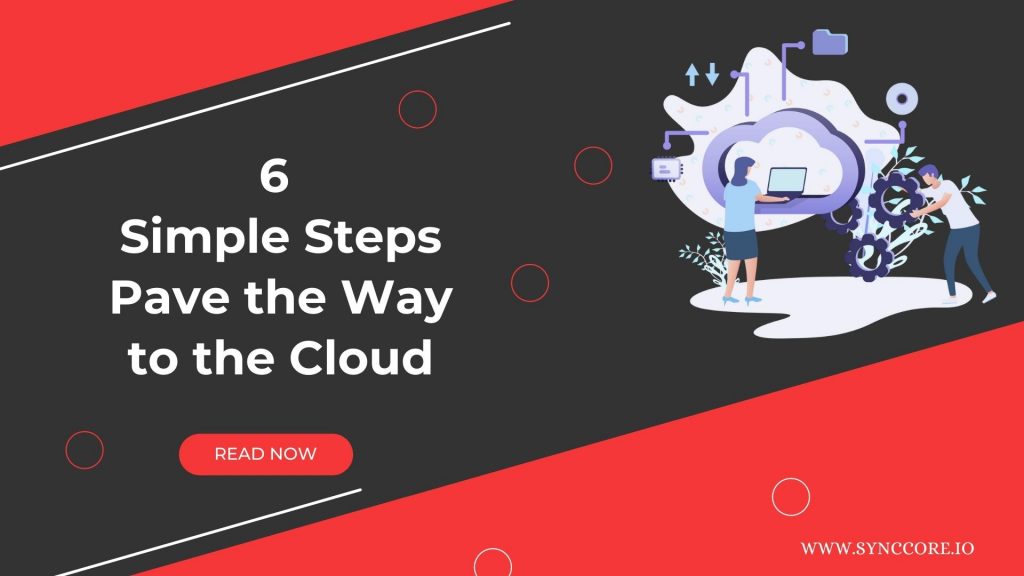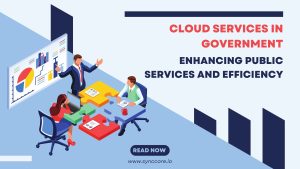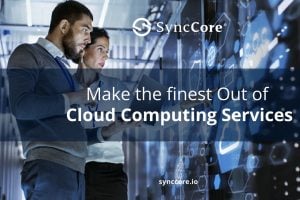Table of Contents
6 Simple Steps Pave the Way to the Cloud
However, many large enterprises struggle to quickly realize business value, enforce standardization, generate cost savings, and build the necessary capabilities when migrating to the cloud. They may also face challenges in expanding beyond the pilot phase to achieve scale.
Many large organizations, for example, have discovered that the IT staff leads cloud initiatives without paying enough attention to business functionality. Following that, the companies generate only a small amount of incremental business value. As another example, a large industrial goods manufacturer moved its IT systems to the cloud without hiring or training new cloud operations personnel.
The company had to rely on IT vendors to manage the systems at the time. Finally, some businesses have tried to run IT systems in their own data centers and the cloud, only to discover that they are spending more money for less reliable services.

According to Synccore’s experience, large enterprises should take six simple steps to reduce risk and increase IT and business benefits.
- Define a cloud strategy that adds value to the business and drives change.
The IT organization should prioritize delivering value to business customers over developing and managing custom IT systems. According to Synccore’s experience, large enterprises can deliver the most value by designing their cloud strategy around four common use cases:
- New Digital Systems
The cloud should be the default option for new IT systems. Most IT departments are unable to compete with cloud vendors’ advanced tools and automation capabilities. Companies can also benefit from these vendors’ hyper-scale infrastructure.
- An Advanced Analytics Platform
Many large companies have struggled for years to establish their own big data infrastructure, with mixed results. Others have recognized that cloud vendor platform as a service (PaaS) choices (such as Google’s Spanner, DataProc, and Big Query) are cost-effective solutions to acquire advanced analytics capabilities, clean up and curate existing data sources, and develop effective data management.
- External Websites and Collaboration Platforms
Almost without exception, enterprises’ external websites and collaboration platforms, such as email and messaging, should be hosted in the cloud. In terms of cost and flexibility, in-house options rarely make sense.
- The Migration of Newer IT Systems
Although certain legacy systems may never be migrated to the cloud due to technological or regulatory constraints, enterprises should make every effort to migrate newer systems. This usually occurs in stages. Before being ported to the cloud as native apps, the systems are first simplified and modernized in-house. The migration does not have to be in its entirety.
It is critical for senior IT and business leaders to state unequivocally that the cloud will be the preferred location for enterprise IT systems. This message has the potential to be a powerful rallying cry for change, ensuring that the cloud does not become just another set of services in the IT infrastructure mix.
Of course, there will be exceptions to this broad-brush approach. Financial institutions, for example, are subject to more stringent regulatory oversight, as are oil and gas companies in some countries. In such cases, businesses may need to retain data rather than expose it to the cloud. Alternatively, many financial institutions will rely on the cloud while maintaining internal golden copies of customer data.
2) Identify The Right Vendors
Enterprises should be cautious when selecting vendors for initial use cases because they will almost certainly play an ongoing role. Choosing vendors necessitates weighing the tradeoffs between having access to specific cloud vendors’ advanced technologies and avoiding vendor lock-in by encapsulating applications and services in containers using Dockers and Kubernetes.
Traditional IT infrastructure vendors will continue to play important roles in hosting data centers as well as building and managing on-premise private clouds for large enterprises that want to avoid public clouds for regulatory reasons.
Enterprises must exercise caution when managing multiple cloud environments in order to acquire best-of-breed solutions. If systems must communicate frequently across multiple clouds and data centers, networking costs can skyrocket. When this occurs, the enterprise may wish to migrate the entire cluster to the same cloud in order to avoid additional networking and cyber-security risks.
3) Shift The Focus Of The It Organization
A successful cloud journey necessitates IT staff focusing on cloud and vendor oversight in five key areas:
- Advisory Services:
Advice on the design of new cloud application services, design guidelines, and a self-service catalog of production IaaS and PaaS options are all covered.
- Architecture:
Covering cloud provider selection, design of development and production environments for cloud services, the introduction of new services, deployment automation, and scripting.
- Security, Identity, Network, and Access Management:
Connectivity to cloud and on-premise data centers, security services, detection and prevention controls, and logging are all covered.
- Operations, Service, and Incident Management:
Covering automated end-to-end performance and security monitoring, troubleshooting, and communication with product engineering support staff from vendors.
Most vendors, but especially large enterprises, lack expertise in these areas. Organizations will need to rely on external resources while training staff, such as purchasing the necessary expertise and borrowing talent from vendors for temporary assignments. Enterprises may also need to improve the incentives they provide, such as compensation and working conditions, in order to attract cloud expertise. For example, a UK bank calculated that in order to attract cloud talent, it may need to raise salaries for certain positions by 50% to 80%.
4) Enforce Clear Architectural Principles
Clear technical design principles should guide both legacy system migration to the cloud and the creation of new systems. Allowing a thousand flowers to bloom is a bad idea.
To limit the growth and complexity of existing technology platforms, ring-fence existing data centers and redirect all new investments to either external or hosted clouds.
Completely automate IT delivery with infrastructure as code and iterative, fast-feedback approaches like agile and DevOps.
Embrace loosely coupled architectures by insisting on full API policy compliance; transition from monolithic legacy systems to a smaller set of cloud-ready standard infrastructure patterns.
All software must be resilient, fault-tolerant, scalable, and infrastructure-independent.
Concentrate on data security and use the migration to clean up and curate existing data sources, codify insights, and implement effective data management.
The degree of discipline required will determine whether the migration results in a more responsive and agile IT environment. If an enterprise simply replicates legacy IT architecture designed for traditional standalone servers and attempts to ensure full backward compatibility with older systems on a private or public cloud, complexity and costs may increase.
Large enterprises, for example, are unlikely to reduce IT costs by building on-premise private-cloud infrastructure unless their internal business and IT teams first simplify and standardize their IT systems. As we will see in the following article, IT architecture design boards and security review processes can help enforce design principles while not stifling cloud adoption.
Existing business applications hosted in enterprise data centers or by third-party outsourcing vendors should be evaluated using three criteria:
Applications That Are to Be Decommissioned
These should be excluded from the migration and typically delegated to IT partners to complete.
The Remaining Applications
These should be evaluated based on whether they are already deployed as a SaaS offering or can be provided by vendors as one.
Applications Without a Ready SaaS Solution
These should go through a series of tests to determine technical constraints such as performance and compliance requirements, as well as migration complexity. This exercise distinguishes three types of applications: those that are cloud-ready or can be adapted to the cloud; legacy applications that can be refactored to move to the cloud; and legacy applications that are not suitable for the cloud because they are built on monolithic legacy architecture, the business risk is too high, or cloud solutions are unavailable.
Typically, this review can be completed using automated tools provided by cloud providers or third-party vendors such as Cast.
Short-term environments, such as those used for development and testing, are typically the first to be moved to the cloud because they benefit from lower unit costs as well as pay-per-use pricing.
Backup storage is frequently the next step. The lower unit costs of services such as Google Coldline, Amazon S3 Glacier, and Azure Blob storage are generally appealing. In some cases, the move allows businesses to streamline backup and archival policies while also reducing the number of backups.
Applications that do not have a ready SaaS solution can be hosted in enterprise data centers, lifted and shifted to a vendor’s data centers, or hosted by an IaaS provider while a migration plan is developed.
Each cloud migration should have a defined sequence and timeline, as well as a concerted effort to simplify and modularize the application architecture. BBVA, for example, is using the cloud to offload transactions from the mainframe, lowering consumption costs.
It is critical to be aware of specific technical, licensing, or contractual constraints for systems that are not cloud-ready. For example, an industrial goods company that uses an SAP ERP system with underlying Oracle databases is migrating all but the most difficult databases to SAP Hana and SAP SQL Anywhere on the cloud; the remaining databases will be hosted on Oracle Cloud as part of a commercial deal that also includes Hyperion and other Oracle products.
6. Industrialize The Transformation And Migrate In Phases
An industrialized approach can reduce migration effort by 10% to 50% for systems that are cloud-ready or can be made cloud-ready, depending on the technology stack, technical constraints, and migration volume.
This industrialization is typically overseen by a multidisciplinary cloud competency center comprised of cloud architects, infrastructure automation engineers, cyber-security experts, and business and finance representatives.
- Lift and Shift
This method is commonly used for hosted applications, in which an existing virtual machine is moved to a cloud IaaS without much modification. This option requires the least amount of effort, but it also provides the fewest benefits, because IT teams are still required to manage, patch, and upgrade these IT systems in the cloud; additionally, the designs of these systems are frequently unable to be efficiently used IT resources available in the cloud.
- Move and Improve
To migrate to the cloud using this approach, the system typically requires some adaptations, most notably to messaging middleware.
- Transform
This approach provides the greatest benefit, but it also requires the most money and effort because existing applications must be refactored to run on a PaaS, typically in portable containers like Docker and Kubernetes. To maximize the benefits of the cloud, compute and storage are also separated.
In practice, most businesses combine these approaches. While a full lift-and-shift approach is generally impractical, it provides a useful baseline for comparing benefits and costs. A full transformation, on the other hand, provides the most benefits but may provide diminishing returns if more than half of the applications are refactored. When more than half of an enterprise’s applications must be refactored, enterprises may begin to see diminishing returns.
Enterprises can pilot each of the three migration approaches with low-risk IT systems to test proofs of concept. For each type of system, early lighthouse projects use a combination of two or three simple and complex applications. These pilots aid in the identification of specific technical constraints, the optimization of automated development and deployment pipelines, and the development of detailed business cases for each cluster of applications.
With the knowledge gained from these pilots, businesses should establish a migration factory, which essentially industrializes the process by relying on standard architecture design patterns, automated testing, and code packaging. Once the strategy and automation are in place, the initial factory can be scaled up and new factories established.
Many large corporations have significant fixed costs associated with running their own data centers. In these cases, a “parking lot” strategy may be advantageous. A large manufacturing company, for example, parked the majority of its applications in an IaaS environment to avoid the cost of refurbishing its data centers. Over the course of several years, the company transformed those applications into a PaaS. This strategy may make sense even for enterprises with efficient data centers—typically when the remaining fixed costs for a data center are 60 percent to 75 percent of total remaining enterprise IT costs.
For most large enterprises, the journey to the cloud can take three to five years. It is determined by the size and complexity of the existing IT landscape, the willingness to change, funding, and unanticipated market and regulatory changes. That may seem like a long time, but it’s preferable to the alternative. Enterprises that take a haphazard approach will achieve haphazard results that ultimately undermine the business case for moving to the cloud.
The cloud provides measurable and quantifiable value. Enterprises can begin to realize this value early by following the steps outlined above to define, identify, shift, enforce, scrutinize, and industrialize. The steps aren’t a stairway to heaven, but they are a practical and efficient way to reach the cloud.



